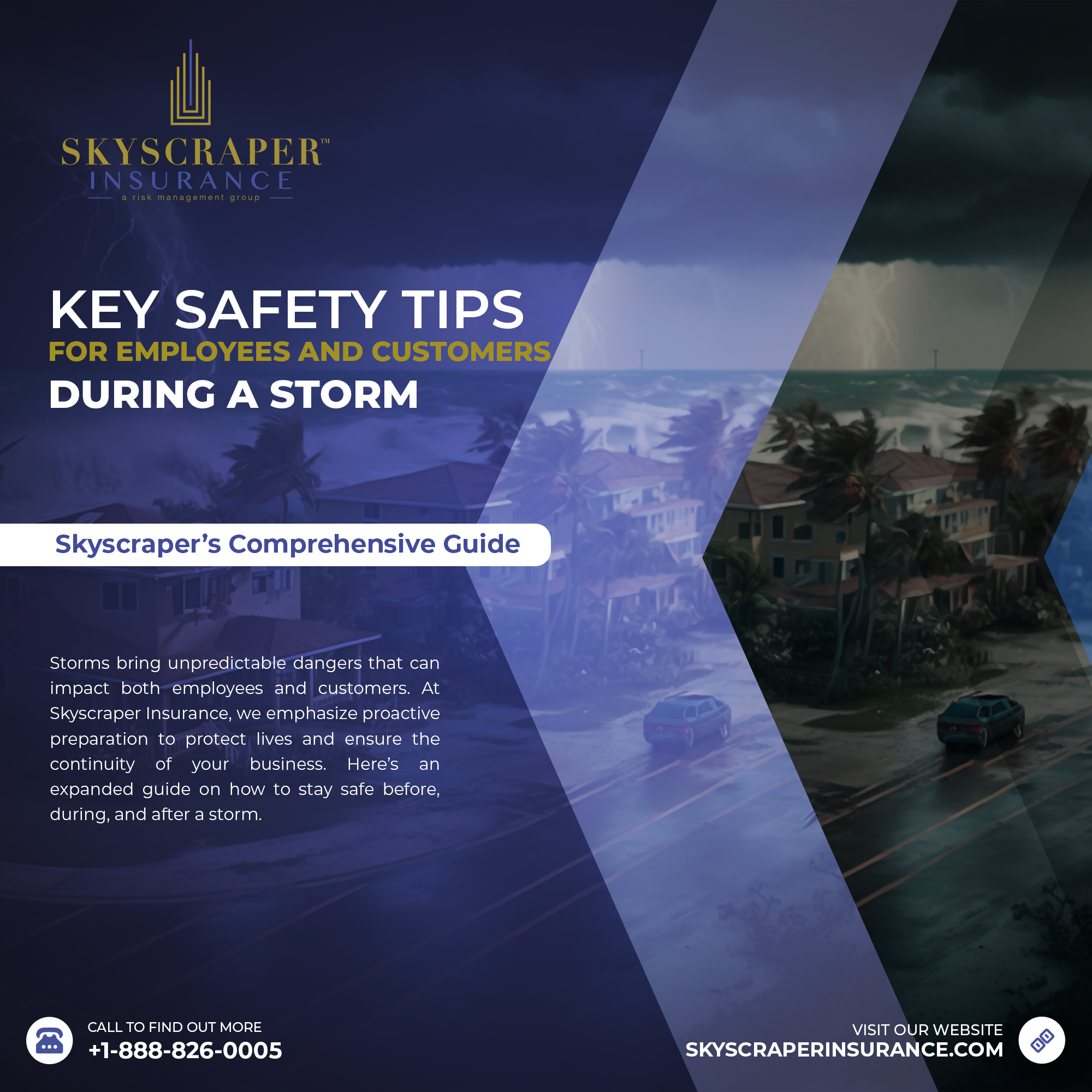Storms bring unpredictable dangers that can impact both employees and customers. At Skyscraper Insurance, we emphasize proactive preparation to protect lives and ensure the continuity of your business. Here’s an expanded guide on how to stay safe before, during, and after a storm.
1. Evacuation Plans: Planning Saves Lives
It’s critical to have a clear and practiced evacuation plan. Ensure that employees are aware of the safest exit routes, and mark meeting locations a safe distance from the building. Regular fire drills and emergency evacuation simulations are a good practice to instill confidence and readiness.
For customers, install illuminated signage and clearly mark exit paths. If a storm warning is issued, communicate swiftly with customers and ensure they understand the evacuation procedures, especially if they’re in a high-traffic business area. Consider having staff members dedicated to customer assistance in case of an emergency evacuation.
2. Emergency Contact Procedures: Effective Communication in Crisis
Communication is essential during emergencies. Create an updated emergency contact list, ensuring all employees know how to reach key personnel. Also, consider using group messaging apps to communicate quickly.
During storms, communication with customers becomes a priority as well. Update them through multiple channels, such as SMS, email, and social media, about business hours, potential closures, or delays. Maintain transparency so customers are informed and can plan accordingly.
3. Emergency Preparedness Kits: Stock Up Early
Every business should have an emergency preparedness kit available for employees. Kits should include flashlights, batteries, first-aid supplies, water, food, and blankets. Businesses should also consider additional supplies like backup chargers for electronics, an emergency radio, and whistles for signaling.
4. Shelter in Place Procedures: Protecting Everyone Indoors
Not every storm allows for immediate evacuation. If sheltering in place is necessary, identify the safest areas in the building—preferably an interior room without windows or a storm cellar. Keep emergency supplies in this designated area and provide employees with clear instructions on how to get there when needed.
In case customers are on-site, ensure you have enough room in your safe spaces to accommodate them. Train employees on how to manage customers calmly and efficiently during shelter-in-place procedures.
5. Post-Storm Safety: Navigating Hazards
Once the storm passes, businesses often face secondary hazards such as flooding, debris, and downed power lines. Employees should be cautious about re-entering buildings, especially if structural damage or flooding is present. Electric wires and water can still be dangerous after a storm, so businesses should avoid flooded areas and report downed power lines to local authorities immediately.
For customers, provide guidance on where it is safe to move. If necessary, arrange for transportation to ensure they leave the premises safely. Display caution signs or block off hazardous areas with barriers to prevent accidents.
6. First Aid and Emergency Training: Equip and Educate Your Team
Ensure your workplace is equipped with proper first aid kits and that employees know how to use them. Basic first-aid training, like CPR and injury treatment, is crucial in the event of an accident. Designate team members as first responders and equip them with radios or other tools to assist in case of an emergency.
7. Remote Monitoring and Business Continuity Plans
Technology can help businesses stay safe and operational. Implement remote monitoring systems to assess storm damage in real-time. It’s also crucial to back up business-critical data before the storm hits. Using cloud storage for customer data and operational files ensures they remain safe, even if physical equipment is damaged.
Establish a business continuity plan that outlines how operations can resume post-storm. For remote employees, disaster-proof communication tools like virtual meeting platforms and secure VPNs will keep your business connected and functioning.
8. Reassure and Support Employees: Mental Health Considerations
Storms are stressful for everyone involved. After the storm passes, check in with employees about their physical and mental well-being. Many might have experienced personal losses or trauma, and providing access to counseling services or simply offering a supportive environment will go a long way.
Skyscraper Insurance: Your Partner in Preparedness
At Skyscraper Insurance, we understand that protecting your employees and customers is the first step in managing risk. With our risk management solutions, we help businesses be storm-ready and resilient. These safety tips are part of our comprehensive approach to minimizing risk and helping you recover faster.




